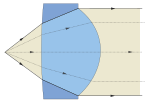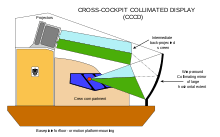Collimated beam
A collimated beam of light or other electromagnetic radiation has parallel rays, and therefore will spread minimally as it propagates. A perfectly collimated light beam, with no divergence, would not disperse with distance. However, diffraction prevents the creation of any such beam.[1]

Light can be approximately collimated by a number of processes, for instance by means of a collimator. Perfectly collimated light is sometimes said to be focused at infinity. Thus, as the distance from a point source increases, the spherical wavefronts become flatter and closer to plane waves, which are perfectly collimated.
Other forms of electromagnetic radiation can also be collimated. In radiology, X-rays are collimated to reduce the volume of the patient's tissue that is irradiated, and to remove stray photons that reduce the quality of the x-ray image ("film fog"). In scintigraphy, a gamma ray collimator is used in front of a detector to allow only photons perpendicular to the surface to be detected.[2]
Etymology
The word "collimate" comes from the Latin verb collimare, which originated in a misreading of collineare, "to direct in a straight line".[3]
Sources
Lasers
Laser light from gas or crystal lasers is highly collimated because it is formed in an optical cavity between two parallel mirrors which constrain the light to a path perpendicular to the surfaces of the mirrors.[4] In practice, gas lasers can use concave mirrors, flat mirrors, or a combination of both.[5][6][7] The divergence of high-quality laser beams is commonly less than 1 milliradian (3.4 arcminutes), and can be much less for large-diameter beams. Laser diodes emit less-collimated light due to their short cavity, and therefore higher collimation requires a collimating lens.
Synchrotron light
Synchrotron light is very well collimated.[8] It is produced by bending relativistic electrons (i.e. those moving at relativistic speeds) around a circular track. When the electrons are at relativistic speeds, the resulting radiation is highly collimated, a result which does not occur at lower speeds.[9]
Distant sources
The light from stars (other than the Sun) arrives at Earth precisely collimated, because stars are so far away they present no detectable angular size. However, due to refraction and turbulence in the Earth's atmosphere, starlight arrives slightly uncollimated at the ground with an apparent angular diameter of about 0.4 arcseconds. Direct rays of light from the Sun arrive at the Earth uncollimated by one-half degree, this being the angular diameter of the Sun as seen from Earth. During a solar eclipse, the Sun's light becomes increasingly collimated as the visible surface shrinks to a thin crescent and ultimately a small point, producing the phenomena of distinct shadows and shadow bands.
Lenses and mirrors

A perfect parabolic mirror will bring parallel rays to a focus at a single point. Conversely, a point source at the focus of a parabolic mirror will produce a beam of collimated light creating a Collimator. Since the source needs to be small, such an optical system cannot produce much optical power. Spherical mirrors are easier to make than parabolic mirrors and they are often used to produce approximately collimated light. Many types of lenses can also produce collimated light from point-like sources.
Display system in flight simulators that uses collimated light

This principle is used in full flight simulators (FFS), that have specially designed systems for displaying imagery of the Out-The-Window (OTW) scene to the pilots in the replica aircraft cabin.
In aircraft where two pilots are seated side by side, if the OTW imagery were projected in front of the pilots on a screen, one pilot would see the correct view but the other would see a view where some objects in the scene would be at incorrect angles.

To avoid this, collimated optics are used in the simulator visual display system so that the OTW scene is seen by both pilots at a distant focus rather than at the focal distance of a projection screen. This is achieved through an optical system that allows the imagery to be seen by the pilots in a mirror that has a vertical curvature, the curvature enabling the image to be seen at a distant focus by both pilots, who then see essentially the same OTW scene without any distortions. Since the light arriving at the eye point of both pilots is from different angles to the field of view of the pilots due to different projection systems arranged in a semi-circle above the pilots, the entire display system cannot be considered a collimated display, but a display system that uses collimated light.
Collimation and decollimation
"Collimation" refers to all the optical elements in an instrument being on their designed optical axis. It also refers to the process of adjusting an optical instrument so that all its elements are on that designed axis (in line and parallel). With regards to a telescope, the term refers to the fact that the optical axis of each optical component should be centered and parallel, so that collimated light emerges from the eyepiece. Most amateur reflector telescopes need to be re-collimated every few years to maintain optimum performance. This can be done by simple visual methods such as looking down the optical assembly with no eyepiece to make sure the components are lined up, by using a Cheshire eyepiece, or with the assistance of a simple laser collimator or autocollimator. Collimation can also be tested using a shearing interferometer, which is often used to test laser collimation.
"Decollimation" is any mechanism or process which causes a beam with the minimum possible ray divergence to diverge or converge from parallelism. Decollimation may be deliberate for systems reasons, or may be caused by many factors, such as refractive index inhomogeneities, occlusions, scattering, deflection, diffraction, reflection, and refraction. Decollimation must be accounted for to fully treat many systems such as radio, radar, sonar, and optical communications.
See also
References
- "Introduction to Laser Technology". Melles Griot Catalog (PDF). Melles Griot. n.d. p. 36.6. Retrieved 25 August 2018.
- "Collimators for Nuclear Medicine". Nuclear Fields.
- Lewis, Charlton T.; Short, Charles (2010) [1879]. "collimo". A Latin Dictionary. Oxford; Medford: Clarendon Press; Perseus Digital Library.
- "Properties of Lasers". World of Lasers. World of Lasers. 2015. Retrieved 5 August 2015.
- Joshi (2010). Engineering Physics. Tata McGraw-Hill Education. p. 517. ISBN 9780070704770.
- Engineering Physics 1: For WBUT. India: Pearson Education India. n.d. pp. 3–9. ISBN 9788131755938.
- Tipler, Paul (1992). Elementary Modern Physics. MacMillan. p. 149. ISBN 9780879015695.
- Winick, Herman; Doniach, S (2012). Synchrotron Radiation Research. Springer Science & Business Media. p. 567. ISBN 9781461579984.
- Mobilio, Settimio; Boscherini, Federico; Meneghini, Carlo (2014). Synchrotron Radiation: Basics, Methods, and Applications. Springer. p. 31. ISBN 9783642553158.
Bibliography
- Pfister, J. & Kneedler, J.A. (s.d.). A guide to lasers in the OR.